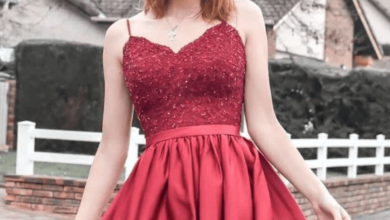How to Start a Clothing Line with No Inventory
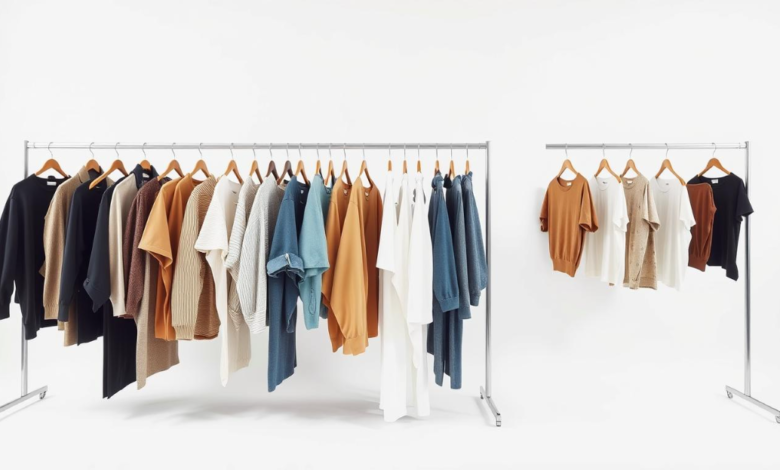
Imagine starting a fashion label without the hassle of unsold products or big upfront costs. This inventory-free revolution is changing how new businesses enter the fashion world. It’s easier than you might think.
Smart partnerships make this possible. Companies like MFG Merch (240 Talleyrand Ave, Jacksonville) offer on-demand production. They handle everything from fabric to shipping. But, picking the right partner is crucial. The wrong choice could ruin your business.
This method lets you focus on design and marketing without the usual risks. You only pay when customers order. Platforms like Shopify work well with these systems, keeping your business lean.
Key Takeaways
- Eliminate storage costs through third-party production partners
- Verify manufacturer credibility using Better Business Bureau ratings
- Leverage print-on-demand tech for custom designs
- Use e-commerce integrations for automated order fulfillment
- Allocate saved capital to brand-building and customer acquisition
Ready to bring your fashion idea to life without the need for a warehouse? The next section will guide you on building your brand while keeping your business agile.
The Concept of No-Inventory Business Models
Imagine starting a clothing brand without worrying about unsold stock. No-inventory models let you focus on creativity. They eliminate storage costs and production risks. This approach is a game-changer for modern entrepreneurs.
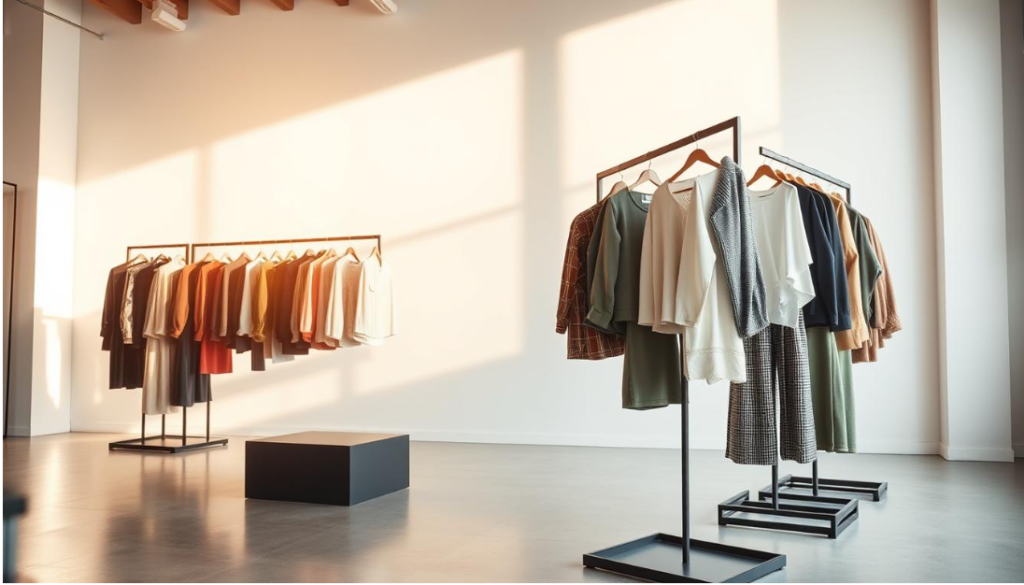
What Is a No-Inventory Clothing Line?
A no-inventory clothing line doesn’t hold physical products. Instead, you partner with manufacturers like MFG Merch (contact: sales@mfgmerch.com). They handle production and shipping only when orders come in. There are two main methods:
- Print-on-demand: Custom designs are printed onto blank apparel after purchase
- Dropshipping: Suppliers ship pre-made items directly to customers
While platforms like Robux have faced criticism, vetted services like MFG Merch show how to create sustainable partnerships.
Benefits of Low-Cost Startup Models
Choosing a no-inventory approach offers distinct advantages for new brands:
- Minimal upfront investment: No need to buy bulk inventory upfront
- Reduced risk: Only pay for products after customers purchase them
- Scalability: Easily test new designs without financial commitments
You’ll spend more time building your brand identity. Less time managing warehouses. This model also lets you quickly adapt to trends. If a design isn’t selling, you can pivot without losing money on unsold stock.
Conduct Market Research for Your Clothing Line
Just like Roblox creators study player demographics to design popular games, you need to analyze fashion consumers to launch a clothing line without stock successfully. Smart market research helps you make data-driven decisions while avoiding costly inventory risks. Let’s break down three essential steps to understand your audience, competitors, and trends.
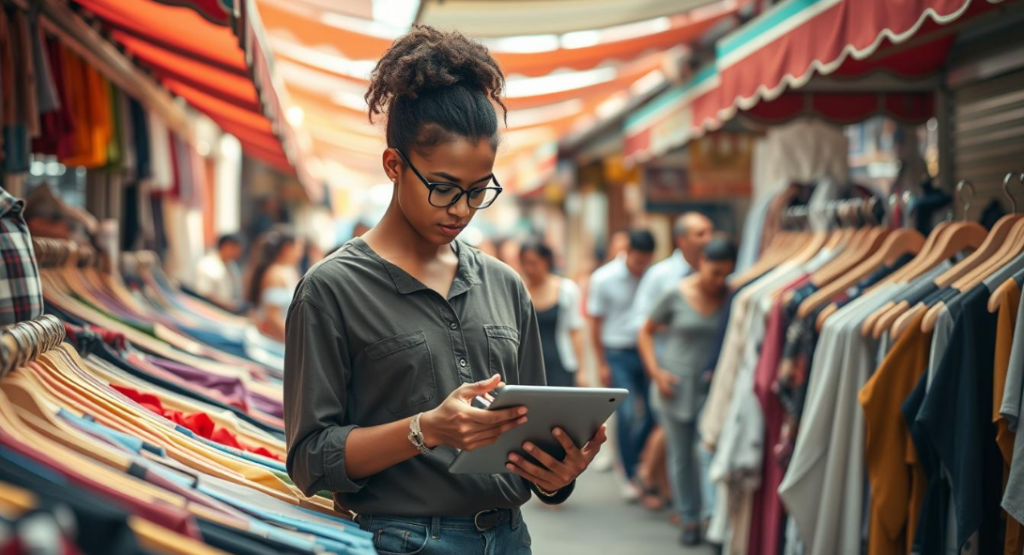
Identifying Your Target Audience
Think of your ideal customer like a Roblox avatar – what accessories would they choose? Start by answering these questions:
- Age range and geographic location
- Preferred styles (streetwear vs. business casual)
- Average spending on fashion monthly
Use free tools like Google Analytics and Instagram Insights to track real user behavior. Notice patterns in what potential buyers search for – terms like “eco-friendly joggers” or “plus-size party dresses” reveal unmet needs.
Analyzing Competitors in the Fashion Industry
Study brands using no-inventory models effectively. Create a comparison table to spot opportunities:
| Competitor | Strengths | Weaknesses |
| Printful Partners | Fast shipping times | Limited custom packaging |
| Etsy Sellers | Strong niche communities | High platform fees |
| Shopify Brands | Full branding control | Requires marketing budget |
Pro tip: Set up Google Alerts for competitor names to monitor their new launches and customer complaints.
Trends to Consider in Your Niche
Stay ahead without inventory risks by focusing on:
- Sustainable materials (bamboo fabric, recycled polyester)
- Virtual fashion for digital avatars
- Gender-neutral collections
“64% of consumers under 35 prefer buying from brands that align with their values” – McKinsey Fashion Report
Test trends through limited print-on-demand releases before scaling. Platforms like TikTok let you gauge interest through viral challenges and hashtag tracking.
Develop Your Unique Brand Identity
Creating a unique brand is key to standing out in the fashion world, starting a fashion line with dropshipping. You’ll need to be creative with print-on-demand while keeping things consistent. Look at Roblox for inspiration, where users create thousands of items with a few design elements.
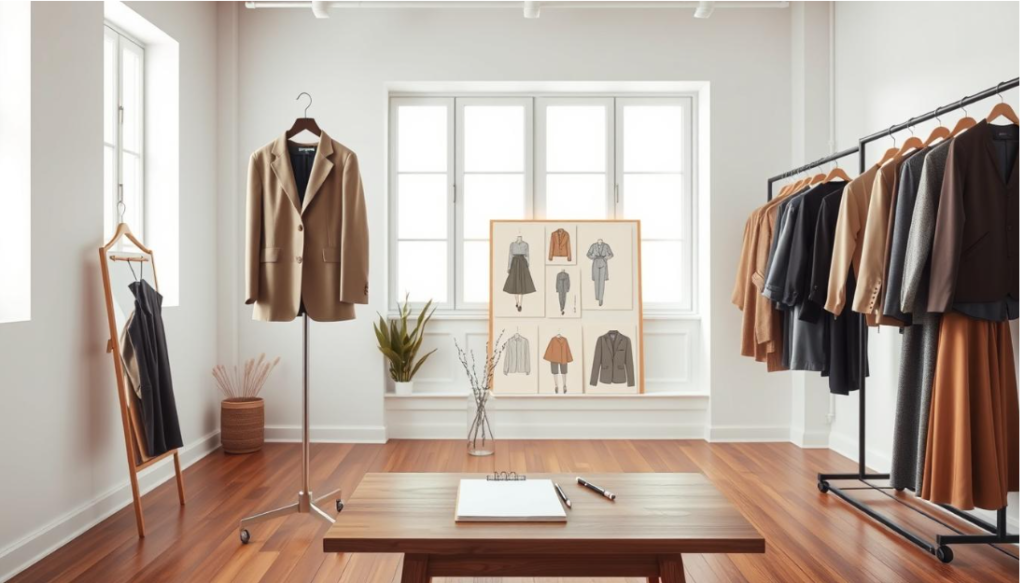
Choosing a Memorable Brand Name
Your brand name is the first thing customers notice. It should be short, catchy, and easy to remember. Test it with friends or online to see if it sticks. Remember to check if the domain and social media handles are available before you decide.
For print-on-demand, pick a name that suggests customization but also leaves room for growth. Names like “ThreadCanvas” or “Ink & Stitch” hint at flexibility, allowing you to explore different niches.
Designing a Logo and Visual Elements
A good logo looks great everywhere, from small Instagram pics to big hoodie prints. Use 2-3 colors that match your brand’s vibe. Make sure to use vector formats for clear prints on all sizes.
Create a style guide with:
- Primary/secondary color codes (hex values)
- Approved fonts for labels and marketing
- Graphic placement rules for different garment types
Roblox’s success with avatar items shows the power of small design elements. Use a “brand stamp” on all products to build recognition.
Create and Source Your Designs
Turning your creative vision into wearable art requires smart design strategies. These strategies should fit a no-inventory business model. This phase blends creativity with practicality, letting you focus on originality while minimizing financial risks. Let’s explore two powerful methods to bring your ideas to life.
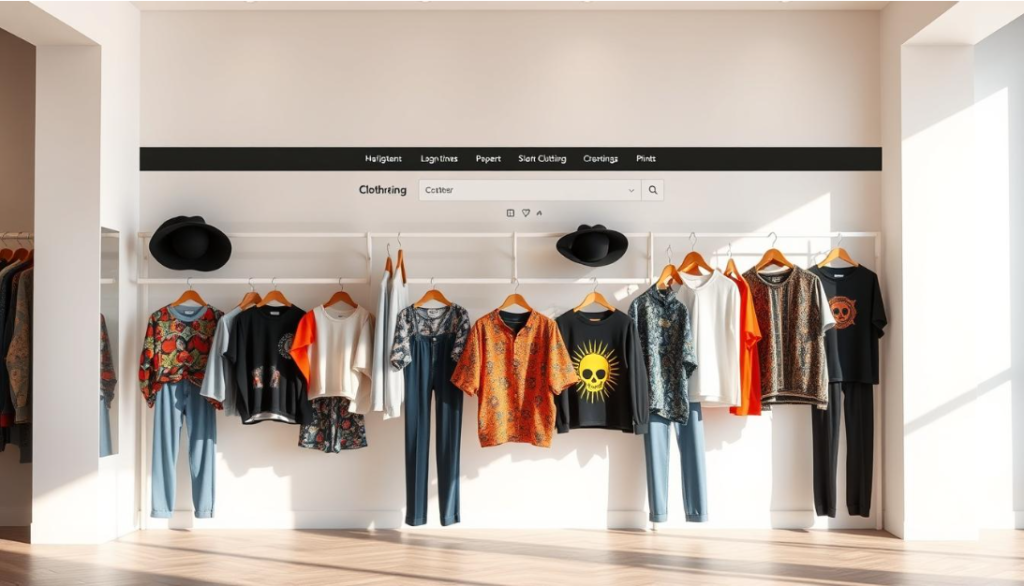
Utilizing Print-on-Demand Services
Print-on-demand (POD) platforms like MFG Merch let you build a clothing brand without upfront costs. They handle production and shipping. Here’s why this works:
- No bulk orders: Items print only after customers purchase
- Customization freedom: Upload designs for t-shirts, hoodies, or accessories
- Automatic fulfillment: Partners like MFG Merch manage inventory and delivery
This model mirrors Roblox’s creator economy, where designers earn royalties risk-free. For hands-on support, contact MFG Merch at (904) 677 9505. Discuss fabric options and profit margins.
Collaborating with Freelance Designers
Not a design expert? Platforms like Fiverr and Upwork connect you with artists. They create unique graphics for your brand. Benefits include:
- Fresh perspectives from global talent
- Flexible pricing (pay per project or hourly)
- Scalability: Hire more designers during peak seasons
Freelancers help diversify your catalog without long-term commitments. Pair their creativity with POD services. This maintains a low-risk, high-reward workflow.
Set Up an Online Storefront
Your digital storefront is the heart of your no-inventory clothing business. It’s like a 24/7 salesperson that needs to wow visitors right away. It should guide them smoothly from looking around to making a purchase. Let’s explore how to create a polished, effective online presence.
Choosing the Right E-Commerce Platform
Not all platforms are created equal for print-on-demand clothing lines. Look for services that work directly with suppliers like Printful or Gooten. Shopify is a top choice with its easy-to-use interface and POD apps. BigCommerce is great for growing fast, and WooCommerce offers lots of customization for tech-savvy users.
Security is a must—choose platforms with SSL encryption and PCI compliance. Just like Robux, make sure your platform keeps security up to date and has fraud detection tools.
Designing a User-Friendly Website
First impressions are key. 53% of mobile users leave sites that take over 3 seconds to load. Pick clean, mobile-friendly themes that highlight your designs well. Use clear, high-contrast buttons for actions like “Customize This Design” or “Add to Cart.”
Organize your site around what customers need:
- Group products by collections (e.g., Summer Tees, Hoodies)
- Include a size guide pop-up on product pages
- Add a live chat widget for instant support
Test every page on different devices before you launch. Can visitors find your print-on-demand customization options in two clicks? Is the checkout process easy? These details are crucial for sales.
Implement a Marketing Strategy
Starting a clothing line without inventory needs creative promotion, even with little money. Like Roblox creators, you can use free tools to grow your brand. Here are three ways to draw in customers without spending on ads.
Social Media Promotion for Your Clothing Line
Instagram and TikTok love real stories. Share videos of your design process or when customers open their packages. Use hashtags like #SustainableFashion or #IndieBrand to find specific groups. Talk to your followers every day by answering comments and working on new designs together.
Building a community like Robux can help. Host polls on new items or share photos of people wearing your clothes. Sharing customer photos builds trust and turns them into your biggest fans.
Engaging Influencers and Affiliates
Work with micro-influencers (5K–50K followers) who match your style. Give them free products for honest reviews instead of paying them. Start an affiliate program where they get 10–15% of sales they help make.
| Collaboration Type | Cost | Effort | Potential Reach |
| Gifted Products | $0 (product-only) | Low | 2K–20K views |
| Affiliate Links | Commission-based | Medium | Unlimited |
| Brand Ambassadors | Discount codes | High | Loyal repeat customers |
Email Marketing Essentials
Start collecting emails right away with a pop-up for 10% off. Send out newsletters every month with:
- New design previews
- Limited-time offers
- Stories of your customers
Mailchimp’s free plan helps you send welcome emails and track who opens them. Sort your list by who’s bought what to send them special deals. This can increase sales by 27%.
“Focus on creating value first. If every email solves a problem or sparks joy, subscribers will stay engaged.”
Manage Orders and Fulfillment
Running a clothing line smoothly means mastering hassle-free order management. Whether it’s ten or a thousand orders, the right strategy ensures fast delivery. You don’t need to store anything.
Understanding Dropshipping Basics
Dropshipping lets you start a fashion brand without inventory. You act as the middleman. When a customer buys, the order goes to your supplier for printing and shipping.
MFG Merch in Jacksonville does all the work. They handle screen-printing, quality checks, and same-day shipping. You never touch the product.
This model works well if you:
- Use print-on-demand platforms with integrated shipping
- Set clear production timelines (3-5 business days is standard)
- Offer tracking numbers automatically
Partnering with Reliable Fulfillment Companies
Choosing a fulfillment partner is crucial. A bad vendor can delay orders, damage your reputation, or lose customer data. Always check:
- Production speed and error rates (ask for performance reports)
- Shipping partnerships (USPS, UPS, or DHL integrations)
- Customer service responsiveness (test their live chat)
MFG Merch is a standout. They offer real-time inventory updates and eco-friendly packaging. One client said: “They reduced our shipping errors by 80% in the first month – crucial when you’re building trust with zero physical stock.”
“Vet partners like you’re hiring a CFO – their reliability directly impacts your bottom line.”
Focus on Customer Engagement
Your clothing line startup without inventory does well when customers feel close to your brand. You can build strong relationships online, unlike traditional stores. It’s not just about selling; it’s about making fans who support your brand.
Building A Community Around Your Brand
Start by listening. Use tools like Hootsuite or Brandwatch to keep up with what people say about you online. When someone tags you or uses your hashtag, reply fast. It shows you care about what they say.
Host virtual events to get people excited. For instance:
- Design challenges where followers submit ideas for new products
- Live Q&A sessions about your sustainable production process
- Collaborative Instagram Stories featuring customer photos
Roblox shows how events can build a community. Try limited-time drops for holidays or cultural events. When fans share their buys online, share their posts to strengthen the bond.
Utilizing Customer Feedback for Improvement
Feedback is like free market research. Add a quick survey to your post-purchase email. Ask:
- How would you rate the product quality?
- What designs would you like to see next?
- Would you recommend us to friends?
Use what you learn. If many say sizing is off, work with your print-on-demand partner to fix it. Share updates like “You spoke—we listened! New extended sizes launching next week.”
Negative reviews? Turn them into chances to improve. Reply publicly with solutions, then follow up privately. This shows you’re serious about getting better.
Monitor Financials and Budgeting
Financial clarity is key in the inventory-free fashion world. You focus on cash flow, profit margins, and budgeting. Here’s how to keep your finances sharp and your brand healthy.
Setting Up Essential Financial Tools
First, you need three must-have systems: accounting software, expense trackers, and tax calculators. QuickBooks or Xero can automate invoicing and connect with your online store. For those without inventory, focus on tools that work with print-on-demand and dropshipping services.
| Tool Type | Top Picks | Key Benefit |
| Accounting Software | QuickBooks Online | Real-time profit tracking |
| Expense Manager | Expensify | Receipt scanning & categorization |
| Tax Prep | TurboTax Business | Deduction optimization |
Keeping Track of Sales and Expenses
Check these numbers weekly to stay on top:
- Cost per design (including freelancer fees)
- Platform transaction fees
- Marketing ROI from social campaigns
MFG Merch is your go-to for branded merchandise with clear pricing calculators. Their dashboard shows exact costs per item, making budgeting easier than traditional methods.
Pro Tip: Set aside 15% of monthly revenue for a “growth fund.” Use it for new designs or marketing tests. This adds flexibility to your budget without increasing overhead costs.
Scale Your Business
When your clothing line starts to do well, it’s time to aim higher. Scaling a no-inventory brand needs careful planning and smart use of tools. Let’s see how to grow without hurting your lean business model.
Recognizing Opportunities for Growth
Your first sign to scale? It’s when you see steady sales and loyal customers. Print-on-demand services let you explore new markets without risk. For instance:
- Add premium fabrics or exclusive designs (like Robux’s membership tiers)
- Target complementary audiences (athleisure lovers if you sell graphic tees)
- Offer bundled items for holidays or special occasions
“Growth isn’t about doing more – it’s about doing what works better.”
Expanding Your Product Range
Want to expand product range without inventory worries? Try these tips:
- Analyze customer requests for trending items (hats, tote bags)
- Create seasonal collections using print-on-demand agility
- Partner with local artists for limited-edition drops
Watch which new items get the most attention. Use that info to improve your offerings every quarter.
Staying Ahead of Industry Trends
The fashion world changes fast. To keep your clothing line going strong, watch for new trends and tech. Use social media and Google Trends to find out what’s popular early. Working with flexible makers like MFG Merch lets you change designs fast, without keeping a lot of stock.
Adapting to Market Changes
What people like changes quickly. What’s cool today might not be tomorrow. Keep an eye on hashtags like #SustainableFashion or #Y2KRevival to see what’s in demand. TikTok and Instagram Reels give you quick feedback.
Try out new designs with print-on-demand services. This way, you can see if they’ll sell before making a big order. Brands like Madhappy and Cider mix classic styles with the latest trends well.
Continuing Education and Networking in Fashion
Learning is always important. Get ideas from places like Roblox’s developer programs. They teach you to keep up with digital fashion trends. Take free courses on Skillshare or at the Fashion Institute of Technology.
Go to online events like Première Vision or join indie designer groups on Slack. Talking to other designers on LinkedIn or Discord can give you new ideas. This way, you can grow your line without keeping a lot of stock.
Always be curious. Look at innovators like Marine Serre or Collina Strada for new ideas. Sign up for newsletters like Business of Fashion or Vogue Business. By learning and working with flexible partners like MFG Merch, your line will get better with each season.
FAQ
How does a no-inventory clothing line work?
A no-inventory model lets you sell custom apparel without holding physical stock. Platforms like MFG Merch handle production, printing, and shipping through print-on-demand (POD). Dropshipping suppliers fulfill orders directly to customers. This eliminates upfront costs and storage hassles.
Why should I use print-on-demand over traditional manufacturing?
Print-on-demand services like MFG Merch let you test designs risk-free—you only pay when an order is placed. Unlike third-party platforms like Robux, which may expose you to scams, vetted POD partners ensure quality control and secure transactions, similar to Robux’s trusted payment system.
How do I choose a reliable fulfillment partner?
Vet partners as rigorously as you’d scrutinize a Robux transaction. Look for transparency in production timelines, return policies, and customer reviews. MFG Merch, for example, operates a Jacksonville facility with streamlined workflows, ensuring fast turnaround and quality assurance.
What e-commerce platforms support mobile-optimized stores?
Platforms like Shopify, BigCommerce, and WooCommerce offer mobile-responsive templates. Prioritize platforms with secure transaction models akin to Robux’s anti-scam measures, ensuring customer data protection and seamless checkout experiences.
Can I start a clothing brand with no upfront investment?
Yes! With POD and dropshipping, you only pay for products once they’re sold. Partnering with MFG Merch eliminates inventory costs, while platforms like Etsy or Shopify let you launch stores with minimal fees. Focus your budget on branding and marketing instead.
How important is mobile optimization for my online store?
Critical. Over 70% of e-commerce traffic comes from mobile devices. Ensure your site loads quickly, has intuitive navigation, and integrates secure payment gateways—mirroring the reliability of Robux’s transaction system to build trust with shoppers.
What risks come with dropshipping suppliers?
Unvetted suppliers may cause delays, poor quality, or scams—similar to third-party risks on Robux. Always verify supplier credentials, request samples, and read reviews. MFG Merch mitigates these risks with U.S.-based production and real-time order tracking.
How do I ensure my designs stand out in a crowded market?
Research trends deeply, collaborate with freelance designers for fresh perspectives, and use POD platforms like MFG Merch to offer unique customization options. Build a bold brand identity through storytelling and visuals that resonate with your audience.
Can I scale a no-inventory clothing line sustainably?
Absolutely. Start small, validate designs with your audience, and reinvest profits into expanding your product range. Partner with scalable fulfillment providers like MFG Merch, which can handle increased order volumes without compromising quality.
How do I handle customer returns or quality issues?
Work with partners who offer hassle-free return policies. MFG Merch, for instance, manages replacements directly, ensuring your brand reputation stays intact. Always communicate clearly with customers to resolve issues swiftly, just as trusted platforms like Robux prioritize user satisfaction.



